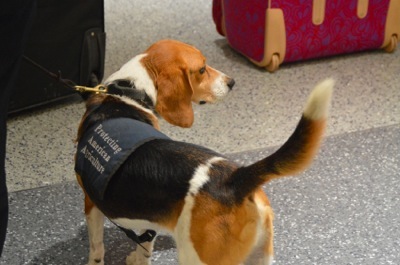It’s all in the nose for detector dogs, but how they work and why they’re so good at it are essential to the military, transportation and other sectors that must defend against unseen threats.
Dogs, like humans, have an areas of the brain that processes all kinds of sensory input – sights, sounds, smells – but their noses are longer and more spacious, making them masters at inhaling odors. They have between 20 and 40 times more odor receptors in their snouts than people, which means that in most cases they can detect an odor at much lower concentrations than humans.
Detection dogs, including bomb sniffers, are typically trained to sense for one type of agent, such as explosives, narcotics, insects or even contraband food or plants. While military working dogs are typically bred for purpose, this is not the case with all types of detection dogs. For example, earlier this year two beagles were rescued from a shelter and have since been trained to detect various fruits and meats for the U.S. Department of Agriculture.
Bomb sniffing dogs are most often associated with the military, and in 2010 these highly-trained canines joined the front lines in Iraq after the failure of mechanical devices to identify explosives. For these dogs, their primary role is defensive: to detect traces of the enemy’s artillery, explosives, hidden bombs or Improvised Explosive Devices (IEDs), the latter of which might not be an obvious visible threat to a soldier.
While the military is a primary customer for these highly trained animals, the growing threat of domestic terrorism has placed a premium on these dogs for uses in transportation, border control, event security and at high-profile locations.
“Vapor wake” dogs have been deployed in New York City, a favorite terrorist target; these canines can smell explosives in a dynamic, moving crowd and home in on the scent. These highly trained dogs are required to achieve such a level of precision and accuracy in their work that 85 percent of candidates do not make the final cut.
Dogs used in border security might be trained to detect any number of prohibited items. Chemical detector dogs can sniff out chemicals of mass destruction, such as sarin and cyanide. Other dogs are trained to find narcotics and even people concealed inside a vehicle, which helps agents identify potential human smugglers. Still others can sniff out money.
The use of dogs to sniff out potential trouble continues to grow. The Canine Detection Research Institute at Auburn University has retrained dogs that were not suited for indoor explosives work to detect pythons. According to one of the biologists involved in the “EcoDogs” program, these animals can cover a search area two-and-a-half times faster than a human. In 2010, two of these dogs were put on assignment for the Army Corps of Engineers to demonstrate their ability to detect pythons that plague an Everglades, Florida park.
A dog doesn’t have to be in the military or a federal agent to put its nose to good use. Increasingly, researchers are working to understand how moderately trained, companion dogs can smell various diseases, including cancer and diabetes.
While your pet dog might not ever need to sniff out bombs, narcotics or cancer, he might provide an early alert to more common household threats, such as fire, gas leak or an unwelcome intruder. When it comes to dogs, respect the nose – because it knows.
What extraordinary things has your dog done with her sensing skills?












0 Comments
Trackbacks/Pingbacks